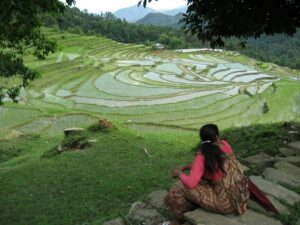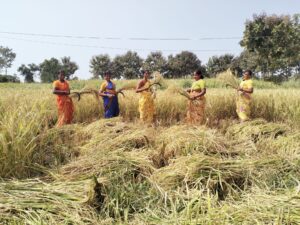In many developing countries, women are the primary managers and users of natural resources. Poor rural women play important roles in rice-based farming systems as unpaid family workers, hired laborers, income earners, and major caretakers of family health and nutrition.
In Asia, although farm size, social and economic class, production systems, and cultural norms vary, women’s contributions range from 25–80% of the total labor use in rice production. Except for land preparation and spraying chemicals, rice operations are dominated by women.
Women’s participation in rice production is highest among lower socioeconomic status farming households in rainfed rice environments. They are also responsible for natural resource management through their day-to-day tasks of providing fuel, water, and food for household consumption and for sale.
Traditionally, the male farmer has been culturally perceived as the head, sole decision maker, and user of technologies. However, this perception no longer holds as males increasingly become part-time farmers. Studies on labor out-migration from major rainfed and irrigated farm households in India, Indonesia, Thailand, and Vietnam revealed that males mostly move away for nonfarm jobs. Consequently, women are taking over responsibilities that were traditionally men’s. Women’s authority on farm-related decisions among households where men move away for other jobs is found to be higher than among those households without such out-migrants.
Women’s roles are beginning to shift from unpaid family workers to de facto farm managers as they take on farm-related decisions and managerial roles. Thus, women who are actively engaged in rice farm- ing should be trained in all aspects of rice production so they can make informed decisions. Key knowledge includes what rice varieties to use on specific land types and associated crop management methods.
Generally, the poorer the household and the more fragile the environment, the greater the participation of female family members in rice production and processing. However, compared with men, women have less access to labor-saving technologies, formal credit, alternative sources of income, and information on improved rice production. International Rice Research Institute (IRRI) projects in collaboration with agricultural research and extension systems and nongovernmental organizations in rice-growing countries are now training women in seed health and crop establishment methods as well as enhancing their income-generating opportunities through, for example, growing nonrice cash crops, mushrooms, and multipurpose trees.
IRRI studies have shown that both men and women agree that land type is a major determinant of choice of rice variety. However, there are gender differences in rice variety preferences based on differences in gender roles in rice production and the use of rice as food and by-products. Thus, there is now a move to ensure that women are consulted on variety selection and that women’s criteria—particularly for postharvest and cooking and eating quality—are considered in plant breeding objectives.
The issues are not limited to gender alone. Labor-saving technologies, for example, can have different employment consequences for women from farm versus landless households. In Vietnam, the plastic drum seeder reduced the drudgery, work burden, and time requirement of women from farming households, but poor and landless women’s wage- labor income declined. Thus, policies and technologies that create alternative income opportunities for poor rural landless women are needed to mitigate the negative consequences of labor-saving technologies.
Despite the crucial roles that women play in sustaining household food security and coping with poverty, gender inequities exist in access to resources, technologies, and opportunities in many agricultural projects and programs. Thus, social analysis—including gender analysis—is important to increase understanding of the gender-based division of labor and gender differences in access to and control of resources and benefits. Reducing gender inequities and tapping women’s potential as agents of change are key strategies for reducing poverty, sustaining household food security and nutrition, and protecting the environment.
____________________
Dr. Paris is a socio-economist and gender specialist in IRRI’s Social Sciences Division.









